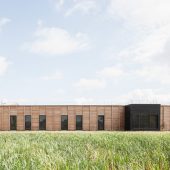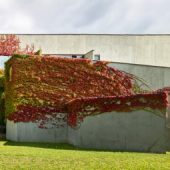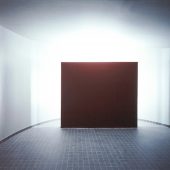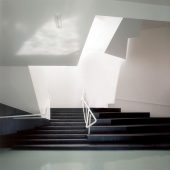This ambitious scientific project will develop research binding the quality of soil and food by dealing with the problems of life cycle and phytosanitary products: soil – plants – vegetables transformation processes – environment. It will provide better visibility to agronomic research and encourage sustainable agriculture in the region, while strengthening the attractiveness of these complementary entities by creating a collective hub.
The project consists of a main volume in wood frame and cladding, which rises in first floor. The entrance to the building is under a cantilever on the south facade of the project, marked by a higher volume, equivalent a second floor and seeming more massive, because it is built in stamped concrete. On the west facade, a terrace draws a hollow joint between the mineral and the plant. Finally, a metal profile horizontally surrounds the project for the passage of special fluids.
The highly technical nature of this type of building involves large networks of varied types and sizes depending on each room and of the type of equipment used. Making the networks visible facilitates maintenance and affirms the technical character of the spaces while leaving the wooden structure of the floor visible. The absence of false ceilings makes it easier to modify the networks over the long term without altering the spirit of the project.
The building is essentially designed with a wooden structure itself clad in autoclave Douglas fir wood cladding. This structure is based on a travertine stamped concrete base (completed with a water-repellent coating) and on the volume of the first floor completed by high shoulders. Wood and concrete complement each other to express firstly the structural choices, but also to bring both a great durability
to the work while integrating more ecological materials. A metal profile surrounds the construction between the ground floor and the first floor in a deep gray color and reinforces the horizontal dimension of the project. The joinery compromises of wood inside and aluminum tinted gray deep outside.
The entrance space is extended inside by a patio around which the building revolves. This allows natural light into the building but also offers the various users a landscaped outdoor space.
It is a place of breathing and relaxation around which the various offices and laboratories are organized. Attached to the patio but also to the reception area is the main staircase which gives access to the first floor. This arrangement around a patio makes it possible to respond to possible changes to the building and also facilitates future restructuring in the medium and long term.
The new INRAE building has constructive provisions that are both adapted to its use and exemplary from an environmental point of view. The structure is made of wood with both wood and concrete floors allowing large spans without intermediate pillars. The networks are visible for easier maintenance and a better understanding of the functioning of the laboratories. The architectural expression seeks first to show a constructive and energetic without forced and complex demonstration. It is a frugal building, a tool at the service of researchers, sober, minimal in its expression, open, transparent, and generous
in its layout and spatial organization; natural light is everywhere. This new center is an architectural landmark in this business district.
By Atelier Téqui Architectes



